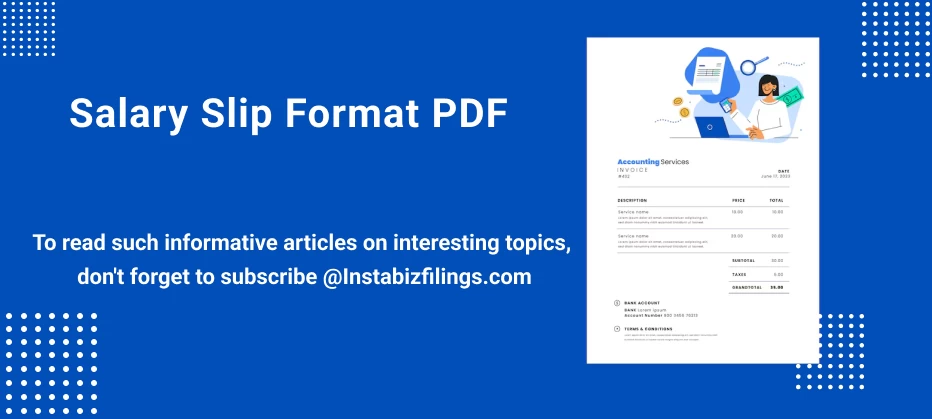
Salary Slip Format
July 26, 2024 by Team Instabizfilings
Paycheck or pay stub also referred to as a salary slip is also a document that caters to the purpose of personnel’s monthly wages and other privileges. It is a document that creates a sense of severance pay to employees and their incomes and deductions would be different from one another. However, here in this article, an attempt is made to describe the schedule of salary slips along with the salary slip format.
Importance of Salary Slip
-
The salary slips serve as identity proof that the person is an employee of the company.
-
This proves that the organization has permanently filled an employee into the employment of the company.
-
This is quite advantageous in bargaining with new organizations/or employers for better remuneration.
-
Salary slips help in getting loans from banks.
-
This one is a genuine proof of income and more to that it can be used to fill income tax returns forms.
-
This document can be used to substantiate the payments for PF and as for insurance premium deductions.
Employment payslips is mandatory to provide to all employees as it is the legal document proving the employment and is used in various legal compliances such as property tax filing and PF return filing. An employee who has not been provided with it can discuss with their payroll department to receive it following payroll generation.
Computerized and Manual Salary Slip
It reflected the payment made to the employee during a specific period as well as the deductions made at the same period.
Manual salary slips are not used at this age because many of us work in computerized offices and the PDF file of the salary slip is forwarded on the date of salary. Likewise, preparing a manual salary slip could take a lot of time as well as a lot of papers are used to prepare them. Computationally, computerized payroll takes significantly less time. Computerised payslip also known as the E-payslip could be printed or be used at the instance of the employee. Lesser cost is involved in it since it is fully automated. It protects the data, thus preserving its sensitivity. Getting manual papers in most cases is to obtain the original salary slip stamped and signed by an official of the company.
Dovetailing from the validity of the salary slip
Discussed below are some of the legal and valid proof documents: the Manual payslip and the e-payslip. It was required that an issued and authorized payslip cannot be altered or changed in any way that is unlawful and becomes criminal to alter a pay slip.
Nowadays many organisations issue a distinct document known as the salary slip.
Handling the payment structure as well as processing payroll is well understood to be an essential corporate function for every human resource and payroll department in any organization. While designing this new salary structure it is also important to make sure that the payslip design should be a tax-efficient one which should also decrease the potential employer’s liability for the future and it should be a legal payslip that should be free from violation of minimum wages and Pf laws. The two sides of the subdivisions of the components are as follows.
-
Income or earnings
-
Deductions
We look into the various components of a salary slip in the paragraphs below: We look into the various components of a salary slip in the paragraphs below:
Income Or Earnings
There are two sides to the payslip in the Philippines, on the left-hand-side of the payslip, all types of incomes or gains or allowances are noted. There are many possible incomes reflected on the payslip of an employee.
DA stands for Dearness Allowance
which is added to the basic salary of an employee, constituting the primary wage of the hired personnel.
This plays a central role and is usually considered the core part of a wage system. As stated, it is the largest component, which can take up to 45 percent to 50 percent of the total compensation given to the employee. This forms the basis for the calculation of other allowances like PF, gratuity ESI, etc Every component is completely taxable.
Like in the case of the basic salary structure, dearness allowance also would impact the other components of salary. Again, it must be pointed out that both basic pay and dearness allowance must not be too much and, at the same time, not too little. If high, they vary with an employee’s tax status. If low it would be the noncompliance to the state’s minimum wage regulation.
House Rent Allowance
The House Rent Allowance, as has been deduced from the name, is an allowance that enables the payment of house rent of employees that could be claimed at year-end. The employee could even get an exemption in save income tax on HRA. HRA would be computed normally as fifty percent of the Income tax. Get to know more about House Rent Allowance.
Conveyance Allowance
This has been mainly added for an employee to be able to transport himself from home to work and then back home and it is tax-free up to a certain amount. The maximum quantity that is tax deductible underlying the facet of this legislation is yearly Rs. 1,600 to annually Rs. 19,200.
Leave Travel Allowance
Leave travel allowance (LTA) concerns the reimbursement of travel expenditure during the leave though restricted to the country’s boundaries only. This component is mainly applied by employers because of its tax incentives. It is for instance possible for an employee to no longer be able to deduct the fare expenses for his/her family while taking a holiday. However, there are restrictions to what you can claim as tax benefits:
-
Only the cost of travel fare can be claimed because the pregnant employee cannot travel for free.
-
Traveling frills, for example, accommodation and food are not included.
-
The travel must be within India Only.
-
LTA only allows for direct family members who fully rely on the employee’s income to be catered for.
Medical Allowance
Medical allowance can be described as a payment made by the employees of an organization by way of reimbursement of their medical expenses. This amount is tax deductible up to Rs. 15,000 for every fiscal year or Rs. 1250 for every month of the fiscal year for the employee. Before being exempted from tax for the provisions under this component, employees must provide an invoice for the medical expenses to be incurred.
Whenever there is no beneficiary to claim the Rs. 1,250 in a particular month then it is pal forwarded to the next month. This also implied that a progressive amount of Rs. 15,000 could be claimed at the year-end. This is also the recommended quota that establishments usually allocate to this portion of the salary structure.
Child Education Allowance
This is paid on account of tuition fees of employees’ children and tax Characteristics of Private Limited Company provided up to the extent of an amount of about Rs. 100 monthly for a maximum of two children. Therefore, this sum remains fixed up to Rs. 2,400 per annum largely.
Special Allowance
Special allowance is the component that is usually applied in an organization to account for the remaining portion of the CTC after the other elements have been provided. This component is fully taxable and is also taken into computations for the Provident Fund.
Deductions
Concessions are parts of the salary package where certain elements of CTC are stripped from the take-home pay of employees. As for the right side of the payslip, we record all sorts of deductions. I will therefore outline the possible deductions inserted on a payslip of a given employee.
Provident Fund
The Provident Fund (PF) rate on Basic + Dearness Allowance + Special Allowance is principally 12%. Here the contribution from the employer's side is 6% and that from the employee's side also is 6%. This is so about establishments, which have twenty or more employees on their payroll. If the basic + DA + Special Allowance of an employee is less than Rs. 15,000 then deduction of Provident Fund is obligatory. Such employees, …, can exclude themselves using form 11 (this is possible in cases where this is the first employment and UAN has not yet been obtained) or simply have the UAN set at Rs. 15,000 hence having UAN deducted. This means that the Monthly Provident Fund contribution for the employees having UAN would be a minimum of Rs. 1800/- per month.
Employees State Insurance
ESI deductions are obligatory for employees whose gross salary does not exceed Rs. 21,000/- per month. It is only implemented in business entities that have 20 or more employees with a gross salary of Rs. 21,000. Part of the preconditions is that employees have to give one percent of their salary. Gross pay, which is equivalent to 75 percent of the employees while employers are expected to contribute 4. Seventy-five percent of the gross salary.
Professional Tax
This is the tax levied by Governments on the employed or earners of remunerations as specified by the professional tax. The states passing the amount of professional tax are Karnataka, Bihar, West Bengal, Andhra Pradesh, Telangana, Maharashtra, Tamil Nadu, Gujrat, Assam, Chhattisgarh, Kerala, Meghalaya, Odisha, Tripura, Madhya Pradesh, and Sikkim. In this case, it is worthy to note that the amount that is logically deducted as professional tax varies from state to state, where this is imposed.
Disclaimer
The information provided in this blog is purely for general informational purposes only. While every effort has been made to ensure the accuracy, reliability and completeness of the content presented, we make no representations or warranties of any kind, express or implied, for the same.
We expressly disclaim any and all liability for any loss, damage or injury arising from or in connection with the use of or reliance on this information. This includes, but is not limited to, any direct, indirect, incidental, consequential or punitive damage.
Further, we reserve the right to make changes to the content at any time without prior notice. For specific advice tailored to your situation, we request you to get in touch with us.


